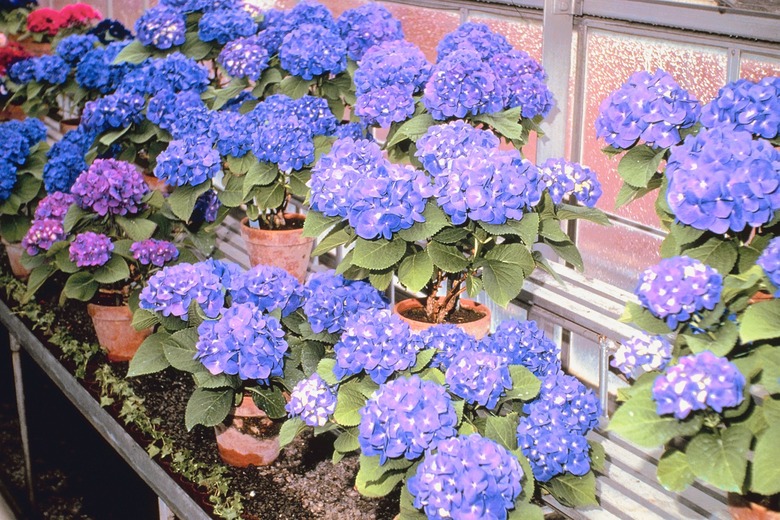When To Change To A Larger Container For Hydrangeas?
To keep a container plant healthy and problem-free, you must repot it to give it space to grow, especially in the case of larger plants, such as hydrangeas. Certain hydrangeas, such as the smooth hydrangea (Hydrangea arborescens), which grows in U.S. Department of Agriculture plant hardiness zones 3 through 9, and oakleaf hydrangea (Hydrangea quercifolia) which grows in USDA zones 5 through 9, grow better in containers than others. All varieties will need repotting every year or two, and will give you signs when repotting becomes necessary.
Roots
Step 1
When the roots of your hydrangea plant start to outgrow the bounds of the pot or become root bound, it's time to give your plant a new home. You can see signs of this if you gently tip the pot sideways and look at the drainage holes for escaping root tips. You may also see roots growing on top of the soil. If you suspect the roots of your hydrangea have encircled the root ball but you can't see any outward signs, remove the plant from its pot. If you can barely see the soil through the roots, it's time to repot the hydrangea.
- To keep a container plant healthy and problem-free, you must repot it to give it space to grow, especially in the case of larger plants, such as hydrangeas.
- If you suspect the roots of your hydrangea have encircled the root ball but you can't see any outward signs, remove the plant from its pot.
Moisture Levels
Step 1
Hydrangeas need consistent moisture to produce their large leaves and flowers. If stressed by drought, the plants will start to wilt or drop their leaves. When a hydrangea becomes root bound, outgrowing its current pot, its roots cannot take up water as easily as when they can grow freely. If your plant needs a new home, you'll notice signs of drought stress soon after watering, or that your plant needs water more often than usual.
Growth
Step 1
The visible portions of your hydrangea can only grow so much when the roots cannot grow. If you notice that, even after fertilizing your plants, the leaves are smaller than usual or the hydrangea simply is not growing, your plant needs repotting. Other signs of stunted growth include yellowing leaves, a lackluster flowering or no flowering.
- Hydrangeas need consistent moisture to produce their large leaves and flowers.
- If you notice that, even after fertilizing your plants, the leaves are smaller than usual or the hydrangea simply is not growing, your plant needs repotting.
Potting Tips
Step 1
For the best results, repot your hydrangea in spring or summer while the plant's roots are actively growing. Choose a pot with drainage holes only 1 or 2 inches larger in diameter than its current pot. When transferring, gently remove the plant and loosen the soil of the root ball, clipping out any black or rotting roots. If you notice any pests living among the roots, try to remove as much soil as you can before transplanting. In the new pot, plant the hydrangea at the same height as it sat in the old pot.
